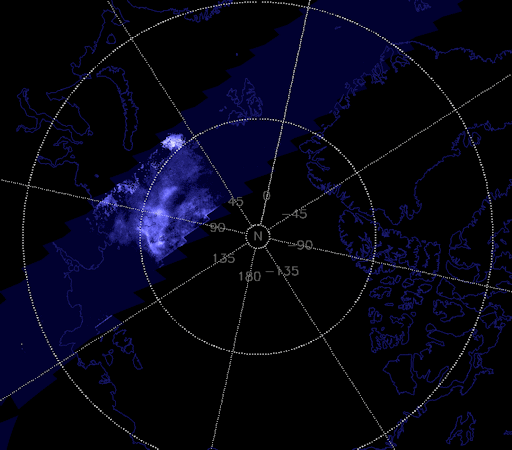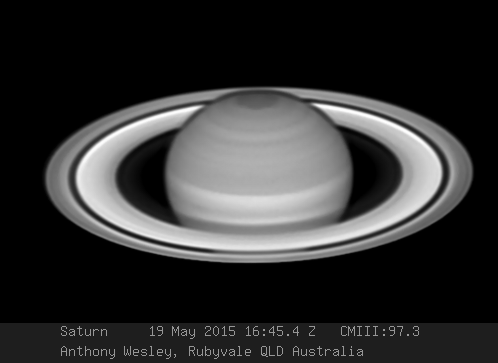Learn to photograph Northern Lights like a pro. Sign up for Peter Rosen's Aurora Photo Courses in Abisko National Park. | | |
CONTINUED QUIET: With no sunspots actively flaring, solar activity remains low. According to NOAA, the odds of a significant solar flare (M- or X-class) today are no more than 1%. Solar flare alerts: text, voice
NOCTILUCENT CLOUD SEASON BEGINS: NASA's AIM spacecraft has spotted a luminous patch of electric-blue drifting across the Arctic Circle. The sighting marks the beginning of the 2015 season for noctilucent clouds (NLCs). "The first clouds appeared on May 19th--a bit earlier than usual," reports Cora Randall, AIM science team member at the University of Colorado. They are located at longitude +90o in this polar image recorded by AIM's CIPS instrument:

The first northern-hemisphere NLCs of 2015, recorded by AIM/CIPS on May 19th
"It is always good to see the beginning of another season," says James Russell of Hampton University, principal investigator for the AIM mission. "What surprises will it bring? We will see. The clouds have never disappointed us."
NLCs are Earth's highest clouds. Seeded by meteoroids, they float at the edge of space more than 80 km above the planet's surface. The clouds are very cold and filled with tiny ice crystals. When sunbeams hit those crystals, they glow electric-blue.
Noctilucent clouds first appeared in the 19th century after the eruption of super-volcano Krakatoa. At the time, people thought the clouds were caused by the eruption, but long after Krakatoa's ash settled, the clouds remained. In those days, NLCs were a polar phenomenon confined mainly to the Arctic. In recent years they have intensified and spread with sightings as far south as Utah and Colorado. This could be a sign of increasing greenhouse gases in Earth's atmosphere.
Data from AIM have shown that NLCs are like a great "geophysical light bulb." They turn on every year in late spring, reaching almost full intensity over a period of 5 to 10 days. News flash: The bulb is glowing. Stay tuned for sightings.
Realtime Space Weather Photo Gallery
SATURN'S RINGS SURGE IN BRIGHTNESS: This Friday night, May 22nd, Saturn will be "at opposition"--that is, opposite the sun in the skies of Earth. The ringed planet rises in the east at sunset and soars through the southern sky at midnight, a golden "star" in the constellation Scorpius. [sky map]
Whenever Saturn is at opposition, its rings surge in brightness. Why? Scroll down for the explanation. On the way, check out these photos taken by amateur astronomer Anthony Wesley on May 19th:

"This is an animation of two Saturn images about 10 minutes apart," says Wesley, who used a 16-inch telescope in Australia. It shows gaps in Saturn's rings, clouds in the planet's atmosphere, and a famous hex-shaped storm around Saturn's north pole.
Getting such Hubblesque results from a backyard telescope requires a combination of good seeing and long years of experience. Wesley is one of the world's top amateur astrophotographers and he routinely produces images like this. Observers with less experience can take good photos, too, especially in the nights ahead as Saturn's rings brighten.
The brightening of Saturn's rings is called the "opposition effect." Saturn's rings are made of frozen chunks ranging in size from dust to houses. Sunlight directly backscattered from those ice particles causes the ring system to shine even more than usual for a few days around opposition. The exact mechanism involves shadow-hiding and possibly coherent backscattering.
If you have a telescope, take a look! Or sign up for a live view of Saturn from Slooh--no telescope required.
Realtime Sprite Photo Gallery
Realtime Aurora Photo Gallery
Realtime Comet Photo Gallery
Every night, a network of NASA all-sky cameras scans the skies above the United States for meteoritic fireballs. Automated software maintained by NASA's Meteoroid Environment Office calculates their orbits, velocity, penetration depth in Earth's atmosphere and many other characteristics. Daily results are presented here on Spaceweather.com.
On May. 22, 2015, the network reported 26 fireballs.
(26 sporadics)

In this diagram of the inner solar system, all of the fireball orbits intersect at a single point--Earth. The orbits are color-coded by velocity, from slow (red) to fast (blue). [Larger image] [movies]
Potentially Hazardous Asteroids (
PHAs) are space rocks larger than approximately 100m that can come closer to Earth than 0.05 AU. None of the known PHAs is on a collision course with our planet, although astronomers are finding
new ones all the time.
On May 22, 2015 there were 1582 potentially hazardous asteroids.
Notes: LD means "Lunar Distance." 1 LD = 384,401 km, the distance between Earth and the Moon. 1 LD also equals 0.00256 AU. MAG is the visual magnitude of the asteroid on the date of closest approach. | | The official U.S. government space weather bureau |
| | The first place to look for information about sundogs, pillars, rainbows and related phenomena. |
| | Researchers call it a "Hubble for the sun." SDO is the most advanced solar observatory ever. |
| | 3D views of the sun from NASA's Solar and Terrestrial Relations Observatory |
| | Realtime and archival images of the Sun from SOHO. |
| | from the NOAA Space Environment Center |
| | the underlying science of space weather |

